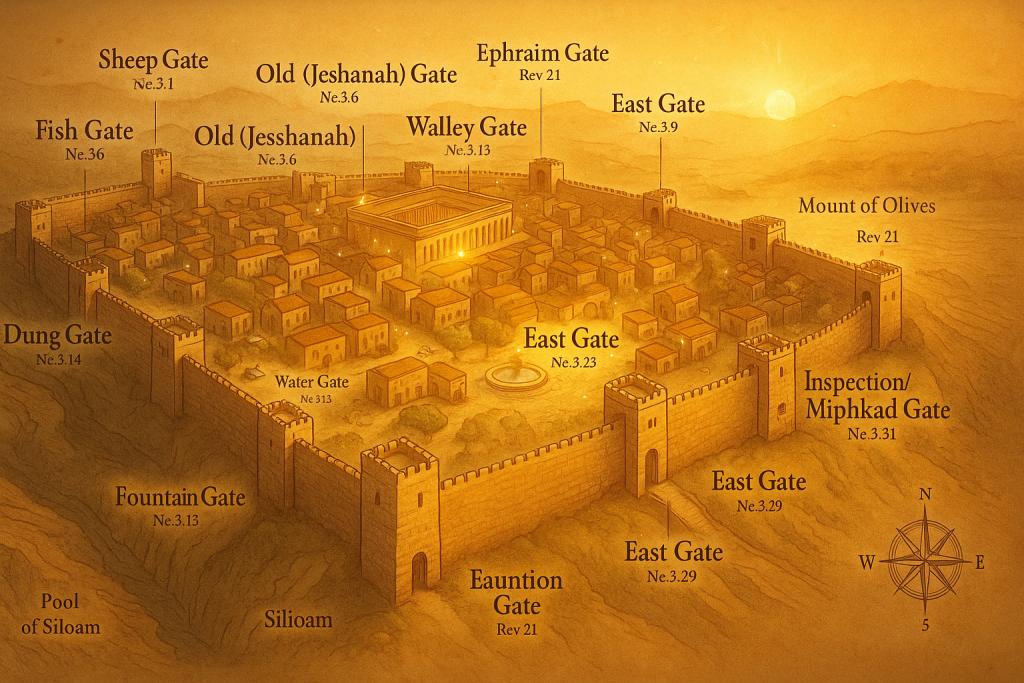The color red carries a powerful weight throughout Scripture, and understanding the Biblical Meaning Color Red opens a doorway to some of the most profound themes in the Old and New Testaments. From the earliest pages of Genesis to the vivid scenes of Revelation, red emerges as a color that speaks of life, sacrifice, danger, covenant, and transformation. Its presence is never casual; it appears at moments when something deeply spiritual is unfolding.

In ancient Hebrew culture, colors were chosen with purpose, and red stood out as a visual reminder of blood both as a symbol of life and as the cost of redemption. This duality gives the color its emotional strength. It can indicate protection, as in the blood of the Passover lamb, yet it also exposes the reality of sin, as the prophets describe in poetic contrasts such as scarlet and snow. Over time, these layers shaped how readers came to interpret the question What Does Red Mean in The Bible, an inquiry that continues to captivate scholars and believers today.
Red also gained prominence in priestly rituals, royal garments, apocalyptic visions, and teachings that explore the human condition. Its meaning shifts depending on context, but it consistently points to moments where God interacts with humanity in a way that demands attention. Because of this, exploring the symbolism of red goes far beyond color psychology; it invites the reader to reflect on themes of divine justice, mercy, and restoration.
As we follow the presence of red across biblical texts, its significance becomes clearer. It is a color that both reveals and heals a color that exposes the depth of human brokenness and the hope of spiritual renewal. Understanding its meaning helps modern readers approach familiar passages with fresh insight, deepening their appreciation for the richness woven into the biblical narrative.
Read also our article about: Biblical Meaning of Big Waves in Dreams.
What Does Red Mean in The Bible
Understanding What Does Red Mean in The Bible requires looking at how the color appears in different contexts and why it carries such a strong symbolic charge. Within the broader study of the Biblical Meaning Color Red, red consistently represents themes that revolve around life, sacrifice, sin, judgment, and redemption. These themes emerge not from imagination but from repeated biblical patterns that give the color a distinct spiritual identity.
In many Old Testament passages, red is directly tied to blood, the most essential symbol of life in the ancient world. Blood represented vitality, covenant, and atonement. Because of this, red often appears during sacred rituals. The Passover in Exodus is one of the most striking examples: the blood of the lamb marked the homes of the Israelites, offering protection and signaling their deliverance. This moment solidified red as a color of divine intervention and covenant preservation.
However, the symbolism of red is not limited to protection or blessing. The prophets frequently used red especially scarlet and crimson to describe sin and moral corruption. Isaiah’s famous contrast between “scarlet sins” and “white as snow” captures the tension between human failure and God’s desire to restore. In these passages, red becomes a visual metaphor for guilt that cannot be ignored but can be transformed.
The New Testament deepens this symbolism through the sacrificial meaning of Christ’s blood. While the focus is not on the color itself, the theological weight carried by His sacrifice naturally reinforces the importance of red. It becomes a symbol of redemption, spiritual cleansing, and the new covenant. This shift creates a bridge between the themes of judgment in the Old Testament and the themes of restoration in the New.
Red also appears in apocalyptic imagery, especially in Revelation, where it signals power, war, and cosmic conflict. The red horse of Revelation 6 represents strife and turmoil across the earth, highlighting the color’s association with intensity and disruption.
Taken together, these examples reveal that red is never a neutral color in Scripture. It signals something that demands attention whether it is the gravity of sin, the cost of redemption, or the intensity of divine action. Exploring these layers helps readers appreciate how the biblical authors used color to convey spiritual truths in a vivid and memorable way.
Red as a Symbol of Life, Blood, and Covenant
Within the broader study of the Biblical Meaning Color Red, few themes stand out as strongly as life, blood, and covenant. These three elements form the backbone of how Scripture uses the color red to communicate spiritual truths. When readers ask What Does Red Mean in The Bible, one of the clearest answers appears in the way red is tied to the very essence of human existence and God’s relationship with His people.
In the ancient Near Eastern world, blood represented more than physical life; it symbolized the divine gift that sustained every living being. This understanding appears throughout the Old Testament. In Leviticus, for example, the life of the creature is said to be in the blood, a principle that shaped Israel’s sacrificial system. Because of this, red became the visual reminder of life offered, life protected, and life preserved by God’s actions.
One of the most compelling examples is the Passover in Exodus 12. The Israelites marked their doorposts with the blood of a spotless lamb, and this red sign served as a covenant of protection. It was not an ornament; it was a statement of belonging and trust. The imagery reveals how red functions as a boundary between death and deliverance, turning the color into both a shield and a testimony of faith.
Red also carried covenantal importance in rituals designed to restore purity and renew the relationship between God and His people. Sacrifices involving blood were not merely symbolic acts but tangible demonstrations of commitment and reconciliation. The color red was woven into priestly garments and tabernacle materials, reinforcing the idea that life and covenant were central to Israel’s worship.
In the New Testament, this symbolism reaches its highest expression. The shed blood of Christ though not described in terms of color fulfills the ancient pattern and establishes a new covenant. The meaning of red shifts from temporary cleansing to eternal redemption, offering a spiritual transformation that aligns with the heart of biblical faith.
Through these moments, red emerges as a color that speaks of life given, life protected, and life renewed. It connects physical existence with spiritual purpose, allowing readers to see how a single color can carry profound covenantal significance across the entire biblical narrative.
Red as a Sign of Sin, Judgment, and Warning
When exploring the Biblical Meaning Color Red, it becomes clear that red carries a dual symbolism. Alongside representing life and covenant, it also exposes the darker realities of sin, judgment, and spiritual danger. These contrasting meanings are part of what makes the color so striking in Scripture. Readers who ask What Does Red Mean in The Bible often discover that red can signal moments of warning times when God confronts human brokenness or announces the seriousness of divine justice.
One of the most recognizable examples appears in Isaiah 1:18. The prophet describes sin as “scarlet” and “crimson,” two shades of deep red that symbolize guilt that runs deep. Scarlet stains were known for their permanence, which makes the metaphor especially powerful. The color exposes wrongdoing in a way that cannot be ignored. Yet even in this stark imagery, God immediately offers hope by promising cleansing and transformation, showing how judgment and mercy often stand side by side.
Red also appears in narratives where violence, warfare, or moral corruption take center stage. The association between red and bloodshed becomes a visual signal of conflict or consequences. This is evident in prophetic books and apocalyptic literature, where red imagery often represents instability, danger, or divine warnings. These occurrences were not meant to create fear for its own sake; they served as reminders of the gravity of turning away from God.
In the book of Revelation, red emerges again in scenes of cosmic judgment. The red horse symbolizes conflict unleashed on the earth, reflecting a world in turmoil. This image reinforces the idea that red can represent a breaking point—a moment when divine justice is revealed and humanity is called to reflect on its path.
Through these examples, the color red reveals a side of Scripture that deals honestly with human failure and the consequences of sin. While it can be unsettling, this symbolism invites readers to take spiritual warning seriously and to recognize the holiness of God. Understanding this dimension of red deepens the study of its meaning and enhances the full picture of its role in the biblical narrative.
The Transformative Power of Red: Redemption and Purification in Scripture
While red often exposes the reality of sin and judgment, it also stands at the center of one of the most hopeful themes in Scripture: redemption. Within the broader understanding of the Biblical Meaning Color Red, the color becomes a symbol of God’s ability to transform what is broken into something restored. This redemptive dimension helps shape a fuller answer to What Does Red Mean in The Bible, revealing a color that moves from warning to healing with remarkable spiritual depth.
Isaiah’s contrast between scarlet sins and white-as-snow forgiveness is one of the clearest examples of this transformation. The same red that represents guilt becomes the backdrop for divine renewal. Instead of being a final verdict, scarlet becomes evidence of a grace that reaches into the deepest stains of the human heart. This movement from impurity to purity shows how red can evolve from a symbol of failure to a symbol of hope.
The sacrificial system reinforces this idea. Bloodshed in the Old Testament was not merely a sign of death; it was a pathway to cleansing. Through divinely appointed rituals, red became a sign that restoration was possible. These symbolic acts prepared the way for the New Testament’s central theme: the redemptive power of Christ’s sacrifice. Though the Gospel writers do not dwell on the color itself, the significance of His shed blood gives red a timeless spiritual meaning.
This transformation also appears in narratives of deliverance. The red thread used by Rahab in Joshua 2, for instance, marked her home as a place spared from destruction. That simple crimson cord symbolized protection, mercy, and a new beginning—turning red into a sign of salvation rather than judgment.
Across these examples, red becomes a bridge between humanity’s need and God’s provision. It reveals sin, yet it also announces forgiveness. It signals danger, yet it also marks the path to safety. It reminds readers of sacrifice, but ultimately directs them toward renewal.
In this way, red becomes one of the most dynamic colors in Scripture. It carries the tension of the human condition while pointing to the power of divine restoration. Understanding this transformative side of red enriches the study of its meaning and highlights why its symbolism continues to resonate so deeply in the faith journey of believers today.
Read also our article about: Biblical Meaning of 300.
Applying the Biblical Meaning of the Color Red to Faith Today
Understanding the Biblical Meaning Color Red becomes even more meaningful when its symbolism is brought into everyday spiritual life. While the historical and theological insights help answer What Does Red Mean in The Bible, the true impact comes from seeing how these themes life, warning, sacrifice, and redemption speak to the challenges and choices of the present.
The first practical insight is reflection. Red appears in Scripture during decisive moments, and this invites believers to pause and consider their own spiritual condition. When red symbolizes sin or moral danger, it encourages honest self-examination. This is not meant to create fear but to foster clarity. Recognizing areas that need change is the first step toward transformation.
At the same time, red carries the promise of restoration. Its association with cleansing and renewal encourages readers to embrace forgiveness rather than remain trapped in guilt. The biblical theme of crimson turning to white serves as a reminder that renewal is always possible, no matter how deep the past may seem. This perspective strengthens faith by shifting the focus from failure to the possibility of grace.
Red can also serve as a symbol of commitment. Just as the covenantal use of blood marked belonging and loyalty in Scripture, modern believers can reflect on what it means to honor their relationship with God. This may involve renewing spiritual disciplines, deepening prayer, or simply remembering the cost of redemption. In this sense, red becomes a visual reminder of dedication and purpose.
Lastly, the color prompts a sense of urgency. In biblical imagery, red often appears when something significant is unfolding. Applying this to spiritual growth means paying attention to moments when God may be calling for change, courage, or action. Whether facing a moral decision, seeking healing, or discerning a new direction, red encourages responsiveness rather than hesitation.
By weaving together these themes, the symbolism of red becomes more than a historical detail. It becomes a tool for insight, encouragement, and spiritual maturity. Bringing the meaning of red into contemporary faith helps believers interpret their experiences with greater depth and walk their journey with renewed intention.


